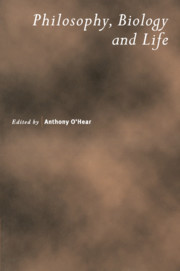Book contents
- Frontmatter
- Contents
- Preface
- Notes on Contributors
- Transcending the Emergence/Reduction Distinction: The Case of Biology
- Other Histories, Other Biologies
- The Ontogenesis of Human Identity
- Souls, Minds, Bodies and Planets
- Evo-devo: A New Evolutionary Paradigm
- Is Drift a Serious Alternative to Natural Selection as an Explanation of Complex Adaptive Traits?
- Evolution and Aesthetics
- The Problems of Biological Design
- Are there Genes?
- Folk Psychology and the Biological Basis of Intersubjectivity
- The Loss of Rational Design
- Under Darwin's Cosh? Neo-Aristotelian Thinking in Environmental Ethics
- The Cultural Origins of Cognitive Adaptations
- Name Index
The Loss of Rational Design
Published online by Cambridge University Press: 07 May 2010
- Frontmatter
- Contents
- Preface
- Notes on Contributors
- Transcending the Emergence/Reduction Distinction: The Case of Biology
- Other Histories, Other Biologies
- The Ontogenesis of Human Identity
- Souls, Minds, Bodies and Planets
- Evo-devo: A New Evolutionary Paradigm
- Is Drift a Serious Alternative to Natural Selection as an Explanation of Complex Adaptive Traits?
- Evolution and Aesthetics
- The Problems of Biological Design
- Are there Genes?
- Folk Psychology and the Biological Basis of Intersubjectivity
- The Loss of Rational Design
- Under Darwin's Cosh? Neo-Aristotelian Thinking in Environmental Ethics
- The Cultural Origins of Cognitive Adaptations
- Name Index
Summary
Introduction
Charles Darwin published his Origin of Species on November 24, 1859. Whatever hurdle the theory of natural selection faced in its struggle for acceptance, its impact on human self-images was almost immediate. Well before Darwin had the chance of applying the principle of natural selection to human origins—in his Descent of Man (1871)—his contemporaries quickly and rashly drew the inference to man's descent from the ape. Satirical magazines like Punch delighted in depicting Darwin with his imposing head on an apish body. At the Oxford meeting of the British Association for the Advancement of Science (June 1860), Bishop Wilberforce asked T. H. Huxley triumphantly whether he traced his ancestry to the ape on his grandfather's or grandmother's side. A wave of evolutionary texts swept over Europe (L. Büchner, E. Haeckel, T. H. Huxley, J. B. Lamarck, C. Lyell, F. Rolle, E. Tyler and K. Vogt). Written in English, French and German, they all had a common focus: the place of humans in a Darwinian world, including religion and morality. Although Darwin contributed the new concept of sexual selection, his Descent of Man is more derivative, less original than his Origin of Species.
- Type
- Chapter
- Information
- Philosophy, Biology and Life , pp. 235 - 258Publisher: Cambridge University PressPrint publication year: 2005



